Journal of “Avicenna Bulletin” was founded in 1999 by the initiative of the Avicenna TSMU Rector, Doctor of Medical Sciences, Professor Kh.K. Rafiev. In addition, Professor M.Ya. Rasuli and Professor A.K. Anvarov played a great role in the birth of the journal. In those years there was a tendency to increase the number of defenses of candidate and doctoral theses, and there were 3 journals in the Republic only, where candidates of scientific degrees could publish the results of their dissertation studies on medicine. It was this fact that prompted the chancellor of the Medical University to create the journal “Avicenna Bulletin“. High demands and requirements, high quality publications, as well as hard work of the Editors, both Editorial Board and Council allowed achieving the recognition of the journal not only in the Republic, but also beyond the country.
In different years the Editors-in-Chief of the journal were well known scientists of the Republic of Tajikistan, Professors: Rafiev Kh.K. (1999-2000), Fayzullaev N.F. (2000-2003), Kurbonov K.M. (2003-2005), Kurbanov U.A. (2005-2016). Since 2016 the Editor-in-Chief is the Rector of Avicenna TSMU, Professor Gulov M.K. For the period of existence of the journal Managing Editors were: Zoirov B.U. (1999), Yuldoshev U.R. (1999-2003; 2005-2007), Marchenko M.A. (2003-2004), Lapina T.V. (2004-2005), Tursunov R.A. (2007-2016), Baratov A.K. (2016 up to present).
Since 2003 the journal is included in the list of the leading peer-reviewed scientific journals recommended by the Higher Attestation Commission of the Russian Federation for publication of the main scientific results of doctoral and candidate theses. It should be emphasized that our journal was one of the first scientific editions of Tajikistan to be included in this list: that year the list consisted of only 11 journals of Tajikistan on different directions of science.
The journal has been presented in the Russian Scientific Citation Index (RSCI) since 2008, which speaks about its role in providing the reader with high quality scientific medical information. Thus, the two year impact factor of the journal has grown from 0.02 in 2013 to 0.453 by 2018, that is 22 times, and the growth of the five years impact factor in the same period was from 0.024 to 0.320, that is 13 times. The rating of Science Index in 2013 was 0.009, and by the beginning of 2018 it equaled 0.046.

Dynamics of the two-year impact factor of the “Avicenna Bulletin”

Dynamics of the five-year impact factor of the “Avicenna Bulletin”

Dynamics of the Science Index rating of the “Avicenna Bulletin“
Of the 75 Tajik scientific journals presented in the RSCI, according to the number of citations, the Journal of “Avicenna Bulletin“ is among the top ten, and according to the Science Index rating ranks 4th among these journals.
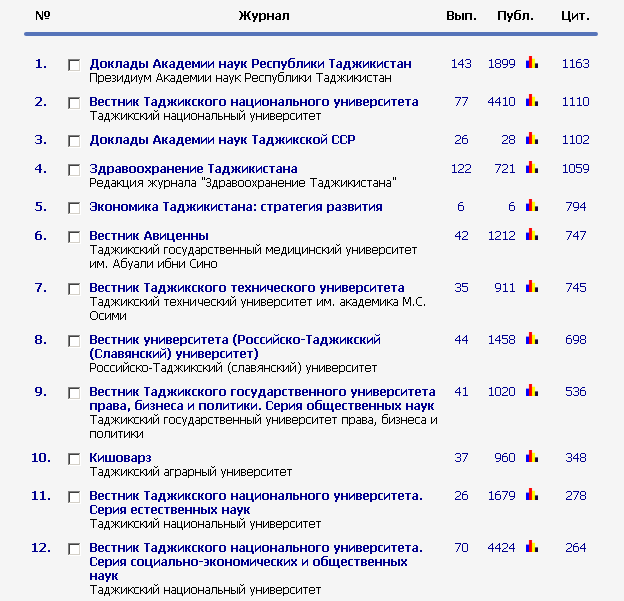
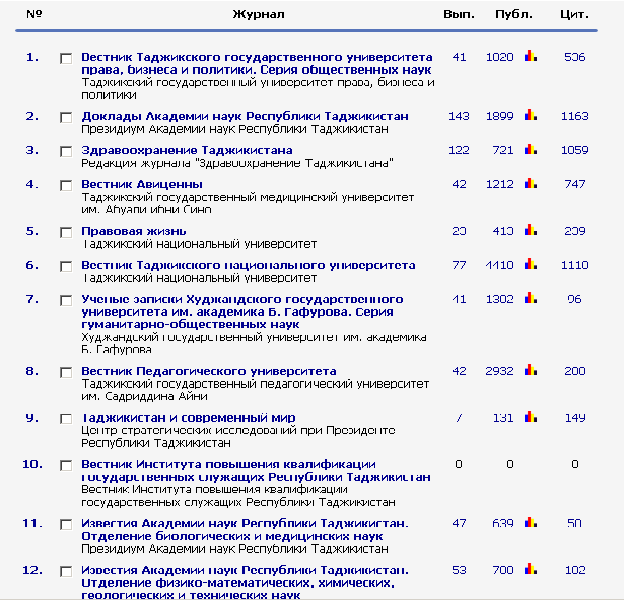
Rating of journals of the Republic of Tajikistan on the number of citations (according to the RSCI) Science Index rating of journals of the Republic of Tajikistan
As mentioned above, during the 20-year period of its existence, the journal published 1641 articles, including 1343 works presented by Tajik scientists. The geography of the remaining articles was distributed as follows: Austria – 1, Azerbaijan – 16, Armenia – 2, Afghanistan – 4, Belarus – 2, Germany – 2, Kazakhstan – 32, Kyrgyzstan – 33, Russia – 191, Uzbekistan – 1, Ukraine – 8, France – 6. If it conditionally breaks the 20-year period of existence of the journal in 2 stages (first and second dec-ade), the number of published articles from the near and far abroad in the first decade amounted to 23, which was 3.9% of the total number of articles, the figures in the second decade rose to 275 and 26% respectively. Thus, the number of published articles of foreign authors in the second decade increased by 12 times. This, of course, testifies to the increasing interest of our foreign colleagues in the “Avicenna Bulletin“ and its greater “recognition“ outside Tajikistan. Since 2009, the “Avicenna Bulletin“ has its International Standard Serial Number (ISSN), which is one of the main attributes of the periodical edition.
By the decision of the High Attestation Commission under the President of the Republic of Tajikistan from December 13, 2018 “Avicenna Bulletin“ is included in the “List of reviewed journals of the Republic of Tajikistan“. Time does not stand still, and the modern scientific community requires a more rigorous approach to the quality of published materials, especially the presentation of reliable information based on use of modern statistical analysis, new methods of research the requirements of most international journals are standardized and integrated into a single standard. The requirements for both publishing and reviewing articles have changed. Taking into account modern standards for publications, as well as the need to log into the new international space, in 2016 a new concept of development of the “Avicenna Bulletin“ was adopted. In particular, the design of the cover was changed, new design of publications was applied according to the most modern requirements, which are used by leading world publishers.
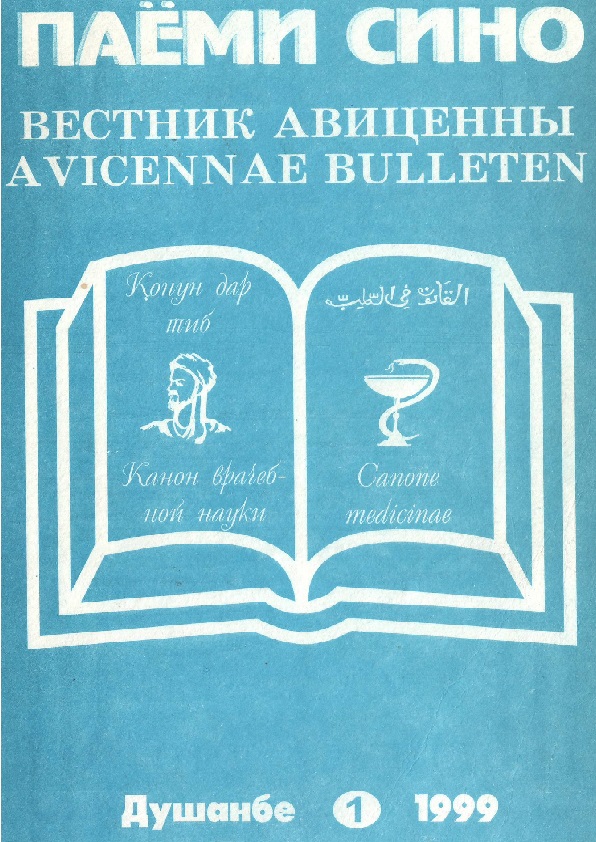
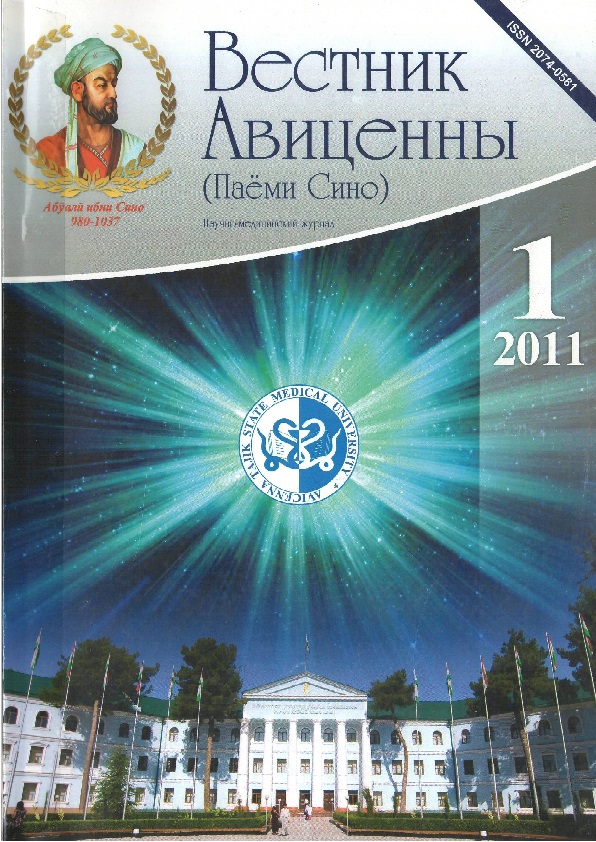
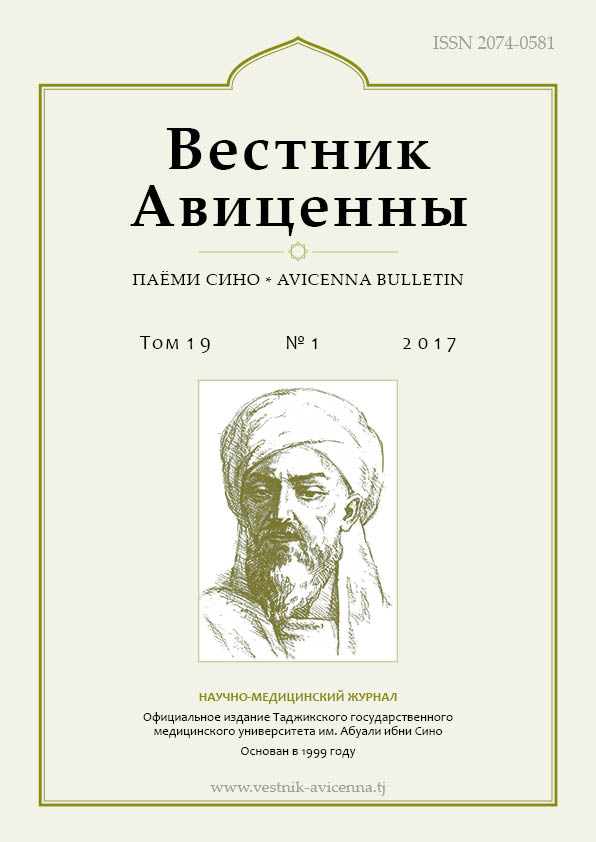
The covers of the “Avicenna Bulletin“ in different years
In 2017, the “Avicenna Bulletin“ was the first among all scientific journals of the Republic of Tajikistan to join the international organization PILA (Publishers International Linking Association), which provided an opportunity for scientists from all over the world to familiarize themselves with the scientific content of the journal. In addition, through the registration agency CrossReff, which is a partner of PILA, each article is assigned a unique identification number – DOI (Digital Object Identifier). It should be noted that the vast majority of internationally recognized scientific journals practice appropriation of their articles index DOI. For what purpose is it done? First, the existing DOI facilitates the process of searching and quoting the article. Second, unlike conventional bibliographic references, DOI is recognized unmistakably, and thirdly, DOI protects intellectual property. With the change of the external design of the journal changed and the requirements for the quality of preparation of manuscripts, which are mainly based on the principles set out in the “Common requirements for manuscripts, presented to biomedical journals”, formulated by the International Committee of Medical Journals Editors (ICMJE). In particular, much attention is paid to the summary of the article as one of the most readable sections of the scientific work. After all, it is the summary in most cases is the only “representative“ of the article or its “business card“ in electronic databases and is available to the most readers. According to the requirements of our journal a summary of the original article in Russian and English should be structured, i.e. have sections: Objective, Methods, Results, Conclusions and Keywords. On the first page of each article since 2018 we have introduced the section “for citation“ in Russian and English, which will facilitate the process of bringing this article as a reference to other authors. The layout and structure of the article itself since the first issue of the journal has not undergone any special changes and consists of standard sections. However, if this was not the case before, it is now mandatory to specify methods of statistical data processing at the end of the section “Methods“. Moreover, particular importance to have a discussion of the results in a comparative aspect with other studies, which, unfortunately, are not always done by the authors, and that, certainly reduces the rating of the article in reviewing.
The requirements for both the number of quoted literature and its quality have changed. So, if earlier many authors were limited to 5-8 references, then according to the current requirements of the journal the number of references in the original article should be 15-30. The mentioned number of quoted literatures testify to acquaintance of authors with the considered problem and quite enough both to indicate actuality of theme, and layout section “Results and discussion“. The following can be noted regarding the quality of quoted literature. In general, the priority is given to journal articles and monographs of the last 10 years. References to conference materials, manuals, etc. are not welcome. Placement of theses, abstracts and normative documents in the list of references is not allowed to refer to normative documents is possible in the form of footnotes. Since 2017 we have changed the standard of bibliographic description of quoted literature using Vancouver style, adopted in many leading biomedical journals. In addition, the existence of a transliterated list of references is obligatory. At the end of the article, sections such as “Information about the authors“,“Information about the source of support in the form of grants, equipment and drugs“ are mandatory attributes, “Conflict of interest“,“Address for correspondence“ and “Contribution of authors“. Most of these sections echoes with the main provisions developed and approved by the Committee on Publication Ethics (COPE).
It is especially necessary to stop on questions of authorship in the article. Unfortunately, there are cases when in the article some, so-called, “authors“ do not correspond to this concept in the root. For the most part they are credited to the author's collective for reasons of majorship, “friendship“, feelings of “gratitude“ and other subjective factors. Sometimes it comes to the absurd, when the co-authors attribute a person not only far, for example, from cardiology, but also from medicine in general. In respect of these persons, provided that they have made any contribution to the study but do not comply with the requirements of authorship, in the “Acknowledgments“ section it is advisable to list their surnames and what they did thus, although the notion of authorship is clearly defined, the problem is far from being resolved. In our journal, as in many others, the authors' contribution section gives information on the following categories confirming the right of the scientist to act as an author: conception and design, data collection, statistical analysis, analysis and interpretation, writing the article, critical revision of the article, general responsibility.
One of the main points in the activity of any serious scientific journal is the process of reviewing. Before the article is sent to the reviewer (the actual review) the manuscript is subject to the primary examination for its compliance with the profile of the journal conducted by the Managing Editor in case of its conformity, the article is obligatory checked by the licensed program “Antiplagiarism“. The “pass-through“ score in our journal is not less than 80% of the uniqueness of the text. The article, which successfully passed both stages, is then forwarded to the reviewer, who is appointed by the Editor-in-Chief. Our journal uses “Single Blind Peer Reviewing“, when the reviewer knows the authors, and for the authors it is hidden reviewer. The reviewer, within a certain period (no more than 2 months), sends to the Editorial Board a special “Review Card“ with points for the results of the review. The basis of this “Card“ is the “Manuscript Review Card” developed by the Media Sphere Publishing House. This card consists of 18 questions that the reviewer must answer. However, this map is not very convenient for reviewing review articles and describing clinical cases. In this regard, we have proposed 2 other Cards for these scientific papers, each with 12 questions. If the reviewer has questions and comments on the article, the latter is sent to the authors for correction. The corrected version of the article is re-checked by the reviewer. In case of a conflict, when the authors do not agree with the opinion of the reviewer, the manuscript is sent to the second reviewer. The fourth stage (Editor-in-Chief, members of the Editorial Board) makes a decision on the expediency of publishing the article. Let us say a few words about the “Open Access Policy” adopted in our journal. First of all, it should be emphasized that the “Avicenna Bulletin“ publishes all articles free of charge from the day of its foundation, which, in our opinion, is a great advantage, largely preventing infiltration. The journal is published on as a means of the founder – the Avicenna Tajik State Medical University and subscribers. An insignificant part of the cost of publishing the “Avicenna Bulletin“ is covered by advertising. On the official website of the journal, its archive is publicly available since 2010, and on the RSCI platform – since 2008.
Issues of responsibility of editors, reviewers and authors, as well as the integrity or dishonesty of the latter is constantly discussed and are among the key in the activities of any journal. There are such unpleasant phenomena as fabrication, falsification, plagiarism, multiplicity of publication, etc. Unfortunately, in the articles submitted for consideration to the “Avicenna Bulletin”, this is the case. So, only in the last 2 years (2017-2018), the editors rejected 46 works out of 298 received (15.4%), including 14 due to low uniqueness, 15 repeated reprints, 6 following low scores on the review results, etc. Of course, work in this direction will continue.
In the middle of 2018, intensive work began on changing the design of the official website of the journal. As mentioned above, the availability of scientific publication materials to the general public is ensured by its presentation not only in scientific information databases, but also on its own official website. It is known that one of the requirements for any serious scientific journal is to have its own website, where at least in 2 languages (for example, English and Russian) all information on the editorial staff, editorial policy, main research areas, and also the rules of registration, articles, archive of numbers provided. At the beginning of this year, a new website for “Avicenna Bulletin“ was launched. Along with the change in the external design of the site, its technical base has been fundamentally rebuilt, including such an important component as the security system. In addition, the website of the journal is presented in three languages: Tajik, Russian and English.
An innovation is the development of the “Articles Tracking” rubric, where by identification number, authors can trace the stage at which their work is reviewed. And, although the indicated heading is not an obligatory section of the website, we consider its placement very expedient for the following reasons. Many scholars, including the authors of this article, who submit manuscripts to various journals, often face the problem of “reaching out” to the Editorial Board in order to learn about the status of their article. Sometimes it takes a long time, and sometimes does not give a result at all. On the other hand, daily calls to the editors or requests by e-mail from the authors take up considerable time from the employees of the journal. We tried to solve this problem by entering this section. In addition, in this section it can be clearly seen the number of rejected works, or articles, withdrawn by the authors, or the so-called “stuck“ manuscripts. Therefore, here we can talk about some “transparency” in the activities of our journal. By the way, the idea of creating the “Articles Tracking” rubric pushed us through the cargo tracking system sent by the world-famous express mail of DHL, TNT, etc., when it can accurately determine their location on the so-called “Tracking number”.
Today, the Editorial Board and the Editorial Council include 60 scientists from Tajikistan, Russian Federation, Azerbaijan, Germany, and France. These specialists represent almost all specialties in 3 areas: clinical medicine, preventive medicine and biomedical sciences.
During the 20-year period of its existence, thanks to the conscientious work of all the former and now existing teams of the “Avicenna Bulletin“, 1648 scientific articles on various problems of modern medicine were published on its pages. In the year of its anniversary, “Avicenna Bulletin“ will continue its glorious traditions based on the principles of objectivity, transparency, goodwill, exactingness, and ethics, and will also intensify work to improve its internal and external content.